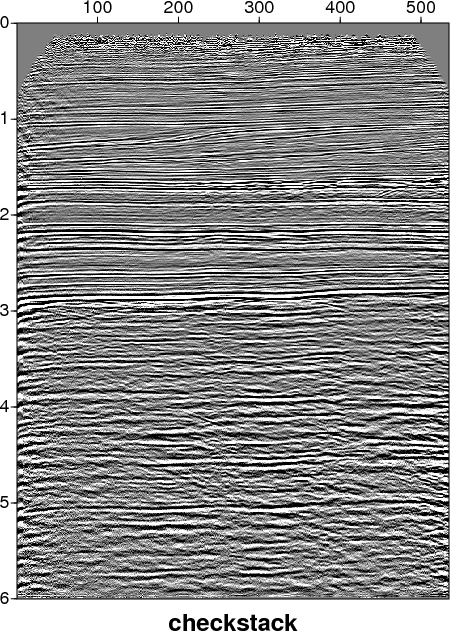|
|
|
|
Open Data/Open Source: Seismic Unix scripts to process a 2D land line |
I found little documentation about loading data and creating trace headers in previous publications. This section described how I loaded the headers.
The three field data SEGY files are downloaded, converted to Seismic Unix format, concatenated, and a print created of the range of each trace header using the command:
scons list1.suOr to use the tar file type:
./list1.job
The resulting listing is:
6868 traces: tracl 1 6868 (1 - 6868) tracr 1 6868 (1 - 6868) fldr 101 168 (101 - 168) tracf 1 101 (1 - 101) trid 1 ns 3000 dt 2000 f1 0.000000 512.000000 (0.000000 - 512.000000)
The print indicates there is little information in the input headers. There are 31 shot records (fldr 101 - 130) and each record has 101 traces (tracf 1 - 101). The trace headers will be created using fldr (the field record number) and tracf (the field trace number). A list of these headers on the first 3000 traces is created using:
scons list2.su
If you are using the tar file type:
./list2.job
Part of the print is:
fldr=101 tracf=1 cdp=0 cdpt=0 offset=0 fldr=101 tracf=2 cdp=0 cdpt=0 offset=0 fldr=101 tracf=3 cdp=0 cdpt=0 offset=0 ... fldr=101 tracf=101 cdp=0 cdpt=0 offset=0 fldr=102 tracf=1 cdp=0 cdpt=0 offset=0 fldr=102 tracf=2 cdp=0 cdpt=0 offset=0 ...
A first display of the seismic data and a zoom of the same data (figures 3 and 4) are produced with the commands:
scons first.view scons zoomfirst.view
If you are using the tar file type:
./first.job ./zoomfirst.job

|
|---|
|
first
Figure 3. First 3000 traces on the first SEGY file. |
|
|

|
|---|
|
zoomfirst
Figure 4. Zoom of Figure 3. The first look at the data. Notice the ground roll and good signal. There are 101 traces in each shotpoint, 5 auxiliary traces and 96 data traces. |
|
|
The first 10 records in the file are test records. These test records are the unusual traces in the left third of Figure 3. The Observer Log does not mention these test records, but indicates the first shotpoint is field file identifier (ffid) 110. There are also 5 auxiliary traces in each shot record. These auxiliary traces can be seen on Figure 4.
The display of shotpoint 24 (Figure 4) is displayed with the command:
scons firstrec24.viewIf you are using the tar file type:
./firstrec24.job
This display as created using suwind to select traces 2324 through 2424, so it is the 24th record in the input file (including the test records). This plot confirms that the 5 auxiliary traces are tracf 97 through 101.

|
|---|
|
firstrec24
Figure 5. The 24th shot record without processing. The last 5 traces traces are auxiliary traces. There is noise on the traces closest to the shotpoint. One trace has a noise burst near the maximum time. |
|
|
The movie display is not included in this paper. The movie loops continuously and can be stopped by pressing 's'. Once stopped, you can move forward or backward using the 'f' and 'b' keys. The movie can be run with the command:
scons firstmovie.viewIf you are using the tar file type:
./firstmovie.job
The trace headers are loaded using the command:
scons allshots.suOr from the tar file:
./allshots.job
The stages in loading the trace header are
InterpText.py is a custom Python script to load the trace headers. The code is not elegant, but it is straightforward and works. This program requires files to define the shotpoint elevation and the 'ffid'/'ep' relationship. The surveyor log defines the shotpoint elevations. The observers log describes the relationship between the su header keys 'ffid' and 'ep' (these are called 'REC' and 'SHOTPOINT' by in the observers log). This information was typed into two files (recnoSpn.txt and spnElev.txt). In addition to interpolating the record number/shotpoint table and the elevation data the program also computes the geometry including the receiver locations and the CDP numbers.
The stack file from the previous process is downloaded and displayed using the commands:
scons checkstack.view scons zoomcheckstack.viewIf you are using the tar file type:
./checkstack.job ./zoomcheckstack.job
The first result is shown in Figure 6. The zoom display is not shown.

|
|---|
|
checkstack
Figure 6. Plot of the SEGY of the final stack from the 1981 processing. |
|
|
|
|
|
|
Open Data/Open Source: Seismic Unix scripts to process a 2D land line |